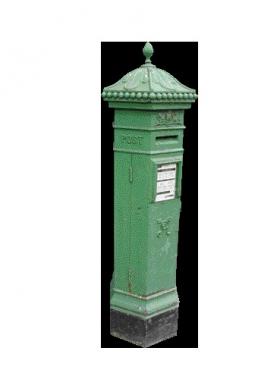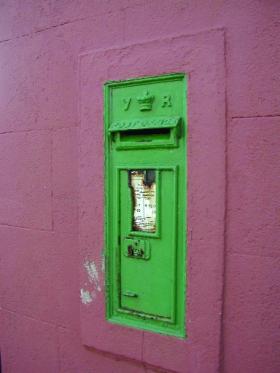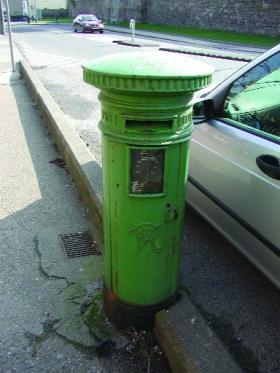Victorian post boxes
Published in 18th–19th - Century History, Features, Issue 3 (May/Jun 2008), Volume 16
the rare ‘Penfold Hexagonal’ in North Street
Modern postal services date back to 1840, when the first ‘penny post’ was introduced in Ireland and Britain by (Sir) Rowland Hill, the British tax and social reformer; until then, letters were charged on a sliding system based on distance to be carried. Cheap pre-paid postage at a uniform rate, and speedy delivery through the developing rail network and the new steamships, resulted in rapid expansion of the postal service. Reduced rates for newspapers and other printed matter also helped, as did the introduction a few years later of the postcard, its despatch to all and sundry soon to be an essential part of any holiday, and the growing popularity of Christmas and other greetings cards.

The three types of Victorian post boxes in County Wexford the majority were wall-mounted like this one (top) in John Street Upper, Wexford.
Post offices were opened in towns throughout Ireland, and post boxes, either free-standing or wall-mounted, became a familiar sight. Today examples of late nineteenth-century post boxes still survive in many places, their original paint well hidden under coats of An Post green but with Queen Victoria’s royal cipher still clearly visible. County Wexford has a number of Victorian post boxes still extant. The National Inventory of Architectural Heritage (NIAH) lists ten so far with the ‘VR’ royal cipher: five in Wexford town, four in New Ross and one in Gorey. Others may remain to be discovered in rural parts of the county. The majority are wall-mounted. Some were made by W. T. Allen and Co., London; others came from A. [Andrew] Handyside and Co., London and Derby, later the Derby Castings Company. They represent early examples of mass-produced cast-iron work and make a ‘pleasant, if discreet, contribution to the aesthetic value of the street scene’.

Main Street North, Wexford, the now-familiar pillar post box, a derivation of the ‘First National Standard Box’ introduced in 1861. (NIAH)
One Wexford post box stands out in particular, however. Nestled beneath the commanding façade of the Royal Court Hotel, North Street, New Ross, is a free-standing post box belonging to a type comparatively rare not only in Ireland but also in Britain. Although commonly referred to as the ‘Penfold Hexagonal’ post box, it was designed by the English architect and surveyor John Wornham Penfold (1828–1909) to be marketed as the ‘New Standard Letter Box’ and may have been influenced by the octagonal post boxes commissioned by Hill in early 1852. Production by the Cochrane Company (fl. 1857–79) of Birmingham and Dudley commenced in 1866.
Complaints made by the public that letters were easily caught up in the corners of the hexagon led, however, to the rise in popularity of the now-familiar pillar post box, a derivation of the ‘First National Standard Box’, which had been introduced as early as 1861. It has been documented that of the approximately 300 ‘Penfold Hexagonal’ post boxes manufactured, only half remain in use to the present day, but with some surviving in such far-flung places as India, Australia and New Zealand—a reminder of the extent of the British Empire in the Victorian era.
Mary Davies is a writer and editor; Damian Murphy is NIAH Survey Controller.
















